

![]() The English Apple Man is enjoying the second week of an early holiday. Malta is very pleasant at this time of year, 15 - 20c.
The English Apple Man is enjoying the second week of an early holiday. Malta is very pleasant at this time of year, 15 - 20c.
From information received from friends & family on the weather back home, it appears the temperature and sunshine/rain balance is changing 'day by day' and even 'Jack Frost' may make an appearance before we get home next week.
The season here (in Malta) is a bit ahead of back home, although the 'locals' tell us it has been the worst winter (that means February) here for many years. Since we have been here its been like back home; one day wet, one day hot (21C) and another day breezy and only 15C.
The English Apple Man has been following up an interest in Bambinella Pears, a specialty in Malta and for the last three years an export 'earner' for Maltese growers.
Because of my link with Malta and my former employer, Worldwide Fruit Ltd. back in the Autumn of 2008 I was asked to investigate the potential of Bambinella.
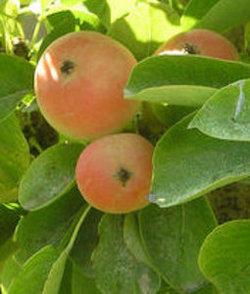 Following a visit to the St. Vincent de Paul Nursery where I met an enthusiastic nurseryman, 'one' Carmelo Briffa, who was producing young Bambinella Trees for commercial growers in Malta, I passed information back to my colleagues back home.
Following a visit to the St. Vincent de Paul Nursery where I met an enthusiastic nurseryman, 'one' Carmelo Briffa, who was producing young Bambinella Trees for commercial growers in Malta, I passed information back to my colleagues back home.
As a result of this initial, very modest investigative visit, a former colleague from Worldwide Fruit visited Malta and set up an import programme for Bambinella. In the first year (2009) 3,000 kg of Bambinella arrived in England and proved to be very successful with Marks & Spencer. Subsequently volumes increased in 2010 and by 2011 an increasing supply of 10,000 kg was exported to England and sold in M&S stores.
This small pear is indigenous to Malta (well, for about a 1,000 years) and is a great favourite with Maltese consumers, so much so that is not uncommon to find other small (imported) pears 'marked up' as Bambinella when it is out of season. One could say it has the same high profile in Malta, that Cox Orange Pippin apples have enjoyed in England.
East Malling Research - Pear Conference.
Last week, I briefly touched on the excellent members day at EMR, this week I will cover more of the presentations.
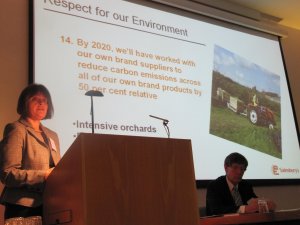 Dr. Theresa Huxley - Senior Product Technologist - Sainsburys.
Dr. Theresa Huxley - Senior Product Technologist - Sainsburys.
Theresa, always an enthusiastic supporter of home grown produce, gave an overview of Sainsburys business plan; "By 2020, we'll double the amount of British fresh produce we sell" she said.
Expressing the opportunity for growers to double UK pear supply and the challenge this represents, gave the growers in the audience an insight into the potential for expansion of our pear industry.
"Sainsburys is the largest retailer of British apples and pears in the UK; a third of all British pears bought in the UK are sold through our stores".
The company has supported the development of the Concept Orchard to increase British varieties, yields and to extend the UK fruit season. The opportunity to increase Conference sales is well known, but the blush pear market is also a valuable opportunity. The Sweet Sensation planted at East Malling Research in 2011, is hopefully a precursor to further investment in UK blush pears.
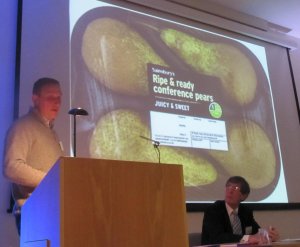 Clive Baxter - Pear Grower.
Clive Baxter - Pear Grower.
Clive Baxter and his family have a long history of pear growing and Clive gave an 'honest' overview of pear growing. Pear Growing; is it profitable? with 55 hectares of pears, with an age range of 6 - 60 years, Clive is a very knowledgeable pear grower. The business has 23 hectares of organic pears and 32 hectares of conventionally grown pears.
Planting density ranges from 1,000 - 1,800 trees per hectare. The latest planting in 2005, utilizes a two leader system, supported on a post and wire structure. Clive believes the 'double leader' system is the best format for producing the size and quality required by our UK retailers.
The new orchard cost £15,000 to plant and has just produced a yield of 20 tonnes per hectare in 2011. His established orchards achieved 40 tonnes per hectare in 2010. Clive comments; "we are getting bigger pears, is it management, or are we beginning to benefit from climate change? Will it get too hot for growing pears on the continent? who knows?
Apples v Pears?
Clive said that based on profitability per hectare, apples are the clear choice, however will we reach a time when, UK Gala is over planted? He feels the longer term scenario may reward the grower who invests in modern pear orchards.
UK Pears are naturally smaller than those on the continent, and smaller than our customers would like them to be; our market is dominated by imports and the price we receive is set by the availability of imported pears.
Higher yields? The use of taller trees, the ability to use natural hormones and improved storage to delay picking, which will result in a 20% increase in fruit size and volume, may change the equation in our favour.
Tony Frankham - Newmafruit Farms Ltd.

Tony Frankham's presentation focused on how Newmafuit have driven better performance from its existing pear orchards to ensure they remain an important part of their product portfolio.
Newmafruit grow 100 hectares of pears. Their latest planting has an intensity of 6,600 trees per hectare. Planted at 3.5 metre x 1 metre on a post and wire support system. Over the last 5 years the company has systematically grubbed old orchards while planting new ones. These orchards are designed to accommodate both mechanical and hand pruning systems to reduced costs while increasing yields.
Newmafruit experience yields of 25 tonnes per hectare on old orchards with their younger orchards achieving circa 38 tonnes. Tony highlighted the fact that Holland & Belgium collectively are increasing their yields by 8% 'year on year'
New plantings here can take 10-15 years to reach full potential. But the performance to date of The Concept Orchard at EMR is 'very encouraging' and if this 'cutting edge' orchard confirms the concept is a viable proposition, it will 'kick start' the UK pear industry's reclamation of an invaluable segment of our pear market.
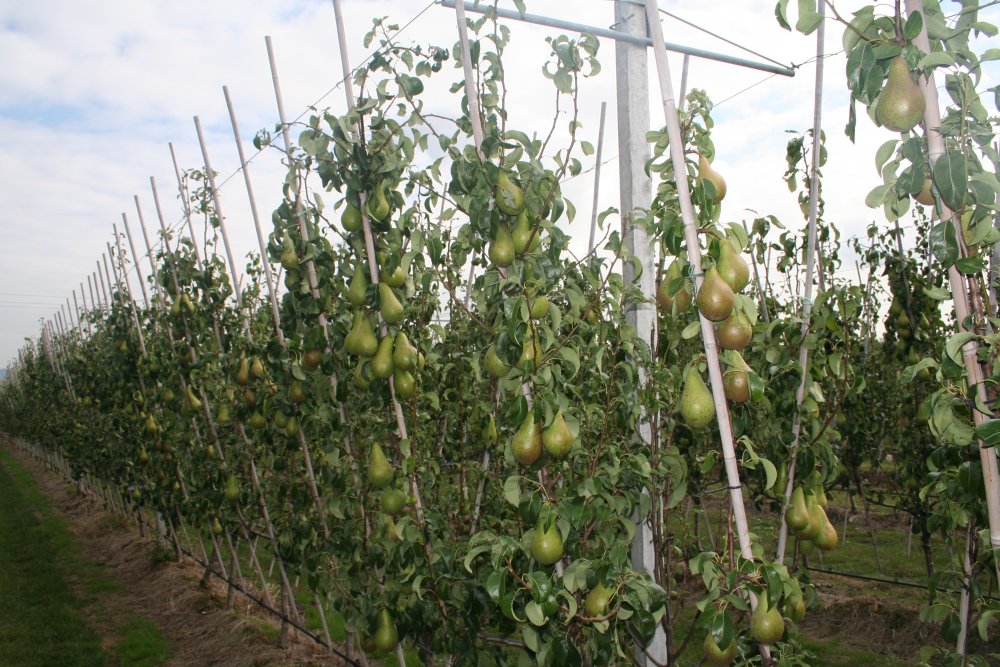
Following Clive Baxter and Tony Frankham's presentations, three more growers revealed their experiences of growing pears in the UK.
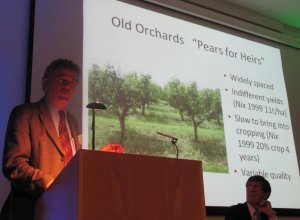 Oliver Doubleday - G.H. Dean
Oliver Doubleday - G.H. Dean
Oliver, eloquent as always, gave us the benefit of his considerable experience of pear growing. Pears for heirs was the title of his presentation, and no doubt his family business has seen the benefit of 'that' generational cycle.
Past history on the farm had centred on wide planting, indifferent yields, variable cropping and slow to come into cropping. Oliver quoted John Nix (Wye College) industry summary of 1999; yields of 11 tonnes per hectare, but only a 20% yield by year 4. Oliver said the old orchards can be 'ranched' profitably, with 'tight control' over fixed costs. They may have a 'present' but they will not have a 'future' and would never repay the planting cost if planted today!
In 2012 Oliver has grasped the latest techniques and planted intensive pear orchards. Knip trees are used for precocity, high density planting; 3.8 metre x 1 metre on post & wire support system, with irrigation and root pruning integral to system. Picking with picking trains is a standard procedure.
 Michael Bentley - Castle Fruit Farm @ Newent.
Michael Bentley - Castle Fruit Farm @ Newent.
When Michael bought the farm circa 2000 he inherited an old pear orchard on a heavily sloped situation. This has now been grubbed and the replacement is a very modern concept. A one hectare Conference pear orchard planted in 2011 features 'double leader' trees planted at 3.5 metre x 1 metre e.g. 2,850 trees supported by a concrete post and wire system. The trees are on Quince Adams rootstock supplied by Rene Nicolai in Belgium. Compost was applied before planting and a full irrigation/fertigation system installed.
By using double leader trees, there are 5,714 fruiting stems per hectare. Michael Bentley forecast yields of 40 tonnes per hectare by year 6 and break even by year seven.
The establishment of £24,802 is expensive but should deliver savings in chemical inputs and pruning & thinning costs. Larger fruits are expected and some reduction in picking costs.
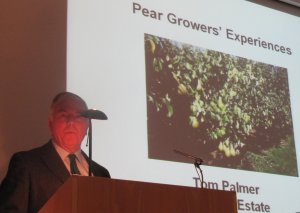 Tom Palmer - Leckford Estate
Tom Palmer - Leckford Estate
Tom Palmer, the 'epitome' of conservatism, illustrated his way of pear growing; in a nut shell, 'keep it simple'
Tom's results are very impressive, with yields and quality to match. None of the Leckford Estate pears have the benefit of irrigation and Tom does not rate the soil as anything more than ordinary, so the yields and quality are surprising.
Tom used an orchard planted in 1987 as his model; Conference on a Quince C rootstock and with a Comice interstock, planted at 4.3 metres x 2.5 metres = 920 trees per hectare. The orchard covers an area of approximately 2 hectares.
The tree training style is 'centre leader / bush'. In 2009 it achieved 38.9 tonnes per hectare; 2010 - 31.9 tonnes and in 2011 - 47.5 tonnes per hectare with a gradeout of 87.5% class 1.
Tom told us the policy at Leckford is to pick slightly later than normal to obtain slightly better sugar levels as Conference Pears are the strongest seller at the Leckford Estate Farm shop.
One very interesting snippet; Tom reminded the audience of the work of Austin Healey at Writtle College many years ago, who advocated a late summer application of nitrogen. The policy at Leckford is to apply 50-80 units of nitrogen in August to improve next years fruit bud formation.
Tom said they use similar cultural methods to most growers in terms of pruning and apply a mulch of straw 'every other year'
Pear Sucker; the dread of many pear growers and the subject of ongoing research has never been an issue at Leckford and they have never 'specifically' sprayed their pear trees for sucker.
Looking forward; Tom said if he planted a new pear orchard he would plant slightly closer than in the past, with a planting distance of 3.8 metres x 1.75 metres with a slightly taller stake, but keeping the tree height to a level where all picking can be carried out from the ground without the need for ladders.
Trickle irrigation would be installed and the cost would be circa £12,000 per hectare + the cost of trickle. This compares to the capital cost of circa £30,000 for an intensive post and wire system.
Next week; 'catch up with the season back home' and more presentations from technical experts at The EMR Pear Conference.
For information on Malta as a country, visit Malta Tourist Website.
Take care
The English Apple Man